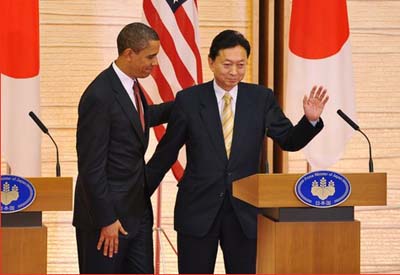This agreement called for its relocation to Camp Schwab in Northern Okinawa. Hatoyama declared that he would terminate the Japanese navy’s involvement in refueling missions in the Indian Ocean when the current agreement expires in January 2010. His party has also insisted on disclosing all information on the secret agreements reached between Japan and the US which allowed American naval vessels to carry nuclear weapons when visiting Japan. Hatoyama has also proposed the idea of an ‘East Asian Community‘ in discussions with China, South Korea and the ASEAN states in a policy shift away from the LDP’s excessive reliance upon the US.
One explanation is that under the DPJ Japan is adjusting to shifting trade relations as China has become Japan’s main trading partner and trade within East Asia outweighs trade with the US. Some have argued that Japan is responding to American decline in the wake of the global financial crisis which has elevated China to a prominent global role. Visionaries have claimed that the changes herald a new era for the Asia Pacific in which US military alliances would be downgraded and a new form of indigenous Asian regionalism would take root. Whatever the appeal of these views it is important to examine the political context for the new government’s moves in which case more sober conclusions may be warranted.
Four factors have influenced Hatoyama which reveal that the changes are internally rather than externally driven. The first is his grandfather Ichiro Hatoyama who was Prime Minister from December 1954 to December 1956 and who searched for greater balance in Japanese foreign policy. To this end he attempted to normalize relations with the Soviet Union and signed the October 1956 agreement with Moscow according to which two islands would be returned to Japan from the disputed Northern Islands. This agreement was scotched by the Eisenhower administration which feared a Japanese accommodation of the Soviet Union. It threatened not to return Okinawa to Japan if the Japanese government followed through on this agreement.
The second factor is a rejection of the LDP’s policy of almost exclusive reliance upon the US alliance which was seen as militarizing Japan and undermining its pacifist constitution. The DPJ on 9 September forged a coalition with Mizuho Fukushima’s Social Democratic party (SDP) and Shizuka Kamei’s New People’s Party (NPP). The SDP is the remnant of the old socialist party in Japan and has strong pacifist views; it has defended the peace clause or Article 9 of the constitution and campaigned against the presence of US forces in Japan. The coalition’s platform included the statement that Japan would make a ‘contribution to the world via an autonomous foreign policy.’ Hatoyama shares the ideas of the Japanese pacifist movement and its NGO supporters and is very sensitive to local Okinawan demands for the removal of the American bases entirely.
A third factor is Ichiro Ozawa, who was DPJ leader from 2006 to May 2009 until a scandal brought him down. Hatoyama appointed Ozawa as DPJ Secretary-General where he wields powerful influence. Ozawa was an American favourite when he was LDP Secretary General over 1989-91, but in time he became noticeably antagonistic towards the US. When he was DPJ leader he vigorously opposed the renewal of Japan’s refueling mission in the Indian Ocean, he described the US occupation of Afghanistan as illegal and called for a Japanese foreign policy based on the UN. Ozawa is regarded within Japan as the power within the DPJ and the puppeteer behind the scenes, while Hatoyama is said to be rapidly losing influence.
Hatoyama has attempted to give expression to a genuine DPJ foreign policy which reflects the coalition of political forces that supports him however his idealism will get him into trouble. His vision of an East Asian Community has not been defined and already China and Japan are sparring over details such as membership and leadership. Hatoyama has said that the idea behind his proposal is yu-ai (友愛) or ‘fraternity’ which does not assist its explanation in practical terms. Moreover, differences between the factions which comprise his party will be exacerbated by the dispute with the US. Foreign Minister Katsuya Okada shares some of Hatoyama’s ideas but he is more willing to accommodate the Americans over the Futenma base issue.
There is also significant opposition from the bureaucracy against antagonizing the US as Japan’s major ally. Japanese newspapers predict that the DPJ would not bear up under the strain of a prolonged dispute with the US and would split. The party conservatives such as Seiji Maehara who is Minister of Land, Infrastructure, Transport and Tourism could join with liberal elements from the LDP to form a new party leaving the idealists and socialists out in the cold. Alternatively, to avert a damaging party split, Hatoyama may be replaced by Okada who was the public’s choice for party leader in May 2009. Whatever happens, Hatoyama has placed himself in a precarious political position.

